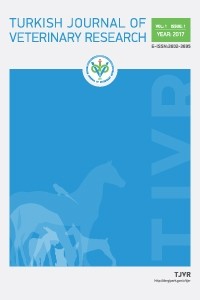Evaluation of the effect of Carvacrol on retinal neovascularization in rats
Evaluation of the effect of Carvacrol on retinal neovascularization in rats
Objectives: To compare the effect of intraperitoneal administered Carvacrol with bevacizumab in an oxygen-induced retinopathy (OIR) model in rats.Materials and Methods: Twenty-eight newborn rats were included in the study and the OIR model was created with the 50/10% oxygen style. The study consisted of 4 groups and each rat in the groups received an intraperitoneal injection of 0.01 mL once on the postnatal 14th day. While the OIR model was not created in Group I (control group), it was created for Groups II, III, and IV. Groups I and II were injected with 0.9% NaCl solution, Group III with bevacizumab, and Group IV with carvacrol. The rats were sacrificed on the postnatal 18th day. Results: Histopathological and immunohistochemical studies showed that the number of retinal vascular endothelial cells (RVECs) and nuclear factor (NF)-κB levels decreased similarly in Group III and Group IV compared to Group II. RVECs values for Group I, Group II, Group III and Group IV were measured as 1.26±0.80, 27.10±3.63, 7.54±1.38, and 6.22±1.22, respectively and it differed significantly between groups (p<0.001). Likewise, NF-κB levels were recorded as 0.61 ± 0.30, 4.36±0.65, 2.68±0.44, and 2.85±0.58, respectively and it differed significantly between groups (p<0.001). On the other hand, RVECs and NF-κB levels were similar between Group III, and Group IV (p values were 0.58 and 0.91, respectively).Conclusions: The study demonstrated that carvacrol significantly reduced retinal pathological neovascularizations, RVECs, and NF-κB levels. Moreover, the observed effects were comparable to those of bevacizumab.
Keywords:
Bevacizumab, carvacrol, neovascularization, nuclear factor-κB oxygen-induced retinopathy, retinal vascular endothelial cell,
___
- Park SW, Kim JH, Kim KE, Jeong MH, Park H, Park B, et al. Beta‐lapachone inhibits pathological retinal neovascularization in oxygen‐induced retinopathy via regulation of HIF‐1α. Journal of cellular and molecular medicine. 2014;18(5):875-84.
- Başlangıç: 2017
- Yayıncı: Ebubekir CEYLAN
Sayıdaki Diğer Makaleler
İbrahim CANPOLAT, Yesari ERÖKSÜZ, Tamara RIZAOĞLU
Evaluation of the effect of Carvacrol on retinal neovascularization in rats
Abdülgani KAYMAZ, Sevilay ERİMŞAH
Şükran ARAS, Ebru KARADAĞ SARI, Serpil DAĞ
Immunohistochemical Investigation of Lipid Peroxidation in Renal Coccidiosis of Geese
Effect of lactation number on milk yield in Holstein dairy cows
Nazmi YÜKSEK, Ege ÇATALKAYA, Yıldıray BASBUGAN, Medine YAYAN
The Evaluation of Arterial Blood Pressure in Anesthetized Dogs with Xylazine and Ketamine
